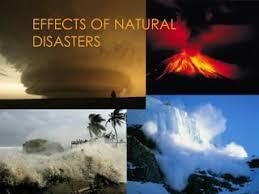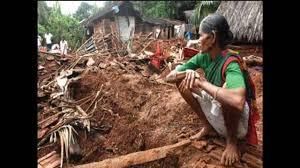GPSC (Goa) Exam > GPSC (Goa) Notes > Goa State PSC (GPSC) Preparation > Goa: Natural hazards and other related effects
Goa: Natural hazards and other related effects | Goa State PSC (GPSC) Preparation - GPSC (Goa) PDF Download
| Table of contents |

|
| Natural Disasters and Their Impacts |

|
| Types of Disasters |

|
| Disaster Risk Profile of Goa |

|
| Goa State Disaster Management Authority |

|
| Goa District Disaster Management Authority |

|
Natural Disasters and Their Impacts

- The occurrence of natural disasters has profound effects on various aspects such as economies, agriculture, food security, water, sanitation, the environment, and health on an annual basis.
- These events pose significant challenges for many developing nations, making them one of the primary concerns in those regions.
- Different types of natural hazards result in varying degrees of physical damage to infrastructure and agriculture, leading to indirect and secondary consequences.
- Droughts typically cause substantial losses in crops and livestock across vast areas of land while often sparing infrastructure and productive capabilities.
- Floods and cyclones can cause extensive damage to both infrastructure and agriculture, the extent of which depends on their timing in relation to the agricultural cycle.
- Earthquakes may not directly impact standing crops but can devastate infrastructure and other productive capacities over large areas.
- The exact costs of disasters in terms of lives lost, property damage, missed development opportunities, and more are challenging to accurately assess, count, or quantify.
- Disasters disproportionately affect certain groups, leading to inequitable distribution of costs that heavily burden only a few.
- Apart from material losses, disasters also give rise to hardships, food shortages, temporary loss of livelihoods, and disruptions to socio-economic activities.
- While some losses can be mitigated through disaster relief and insurance, it's essential to recognize the psychological and social dimensions of such disturbances and study them alongside economic impacts.
Types of Disasters
- India established a High Powered Committee (HPC) on Disaster Management in August 1999 to create comprehensive plans for the national, state, and district levels in response to the escalating frequency and impact of both natural and man-made disasters.
- The HPC emphasized the necessity of a comprehensive and holistic approach towards addressing all disaster types, moving away from fragmented response strategies towards a coordinated, inclusive method.
- Thirty-one disasters have been identified in India and categorized into five sub-groups based on their generic origins and the involvement of various departments/ministries:
- Water and Climate Related Disasters: This category includes disasters like floods, cyclones, tornadoes, hurricanes, hailstorms, cloud bursts, heat waves, cold waves, snow avalanches, droughts, sea erosion, and thunder and lightning.
- Geology Related Disasters: Geological disasters encompass landslides, mudflows, earthquakes, dam failures/bursts, and mine fires.
- Chemical, Industrial & Nuclear Related Disasters: This category involves chemical and industrial accidents, as well as nuclear disasters.
- Accident Related Disasters: Accidental disasters consist of forest fires, urban fires, mines flooding, oil spills, major building collapses, serial bomb blasts, festival-related incidents, electrical disasters and fires, air/road/rail accidents, boat capsizing, and village fires.
- Biologically Related Disasters: Biological disasters include epidemics, pest attacks, cattle epidemics, and food poisoning.
Question for Goa: Natural hazards and other related effectsTry yourself: Which category of disasters includes events like floods, cyclones, droughts, and heat waves?View Solution
Disaster Risk Profile of Goa

- Goa experiences two main types of disasters:
- Natural Disasters: These include events like earthquakes, floods, heavy rains, cyclones, landslides, and tsunamis.
- Manmade Disasters: These are incidents such as oil spills in the sea or on land, gas leaks, explosives, mine collapses, and more.
- South Goa District is considered relatively safer in terms of human and property loss during disasters. The prevalent disasters in South Goa include:
- Floods
- Landslides
- Accidents
- Fires affecting markets, properties, and crops
- Gas leaks
- Cyclonic winds and tree falls
Vulnerability to Earthquakes
- Goa is situated in seismic zone IV, indicating a high likelihood of earthquakes.
- It falls within Zone IV of India's seismic zoning map, classifying it as a moderate seismic zone.
- While Goa has not experienced direct earthquakes historically, it has felt tremors from significant quakes in neighboring states.
- Instances like the earthquakes in "Koyana" and "Latur" in Maharashtra in 1967 and 1993, respectively, with magnitudes above 5.0, impacted Goa's infrastructure and structures, though no casualties were reported.
- North Goa's earthquake vulnerability is relatively low, with towns posing more risk due to higher population density.
- A concerning issue is the construction of numerous buildings, both private and public, lacking proper earthquake-resistant features.
- Given Goa's status as a tourist destination, there are 431 listed heritage buildings that require earthquake-resistant measures.
Vulnerability to Landslides
- Landslides are a common disaster, often occurring in areas disturbed by human activities.
- While landslides do occur in forested areas, those in settlement areas pose a greater risk to human life.
- Geologists believe that unscientific and reckless hill cutting is a major cause of landslides.
- When proper gradients are not maintained, the interlocking of boulders and the soil's grip weaken, leading to boulder sliding, soil erosion, and tree uprooting.
- Structures within the affected area are destroyed.
- The primary victims of landslides are life and property, but essential services such as clean drinking water, power supply, and telecommunication are also disrupted.
- If a landslide occurs during the monsoon, there is an increased risk of epidemics spreading.
- The landslide on the Mapusa–Panaji NH-17 during the 2007 monsoon was particularly severe, obstructing vehicular traffic for almost a month.
Vulnerability to Cyclones
- Tropical cyclones are among the worst natural hazards due to their severity, frequency, and widespread destruction.
- Severe cyclones cause immense damage to non-engineered buildings like thatched roofs and tiled houses.
- They also significantly damage semi-engineered buildings such as schools, workshops, and factories.
- Well-engineered structures, including communication and windmill towers, are also affected.
- A key aspect of reducing cyclone risk is ensuring the availability of adequate shelters, community centers, school buildings, and places of worship.
- Both coastal and interior areas can suffer from gusty winds, which damage property, crops, and trees, endangering lives of people, including fishermen, and damaging livestock, ships, barges, boats, and fishing trawlers at ports.
- Cyclonic winds accompanied by heavy rainfall can cause flooding in low-lying areas, including in Goa.
Vulnerability to Floods
- North Goa district has not experienced major floods recently, except for events in 2000 (Bicholim), 2005 (Mala, Panaji, and Bicholim), and 2007 (Bicholim) due to overflowing rivulets, which caused significant property damage but no major casualties.
- North Goa is traversed by three main rivers: Terekhol, Chapora, and Mandovi, and one minor river, Baga.
- The River Mandovi has 10 tributaries: Madei, Surla, Kotrachi, Ragda, Khandepar, Kudnem, Valvanta, Bicholim, Assonora, and Sinker.
- Bicholim and Sattari Talukas are primarily affected by floods from River Valvonti, while Tiswadi, Bardez, Pernem, and Ponda Talukas are affected by low-lying areas or temporary rises in water levels of nearby rivulets.
- In villages, natural watercourses like streams and nallahs can be blocked by silt, trees, and debris, causing water to rise and inundate low-lying areas, cutting off localities from the rest of the world.
- The primary concern, besides property loss, is the potential spread of epidemics and waterborne diseases.
- While the causes and effects of floods are devastating, measures can be taken to control and reduce the loss, even if the disaster cannot be entirely eliminated.
Vulnerability to Accidents
- Bomb Blasts and Sabotage: Terrorists and antisocial elements often target crowded areas such as the airport at Chicalim, railway stations in Margao and Vasco-da-Gama, and main markets in these towns for bomb blasts and other acts of sabotage.
- Industrial Accidents: Major industries in Goa have developed on-site emergency plans, and the District Administrator has prepared an off-site emergency plan. Government departments and local bodies are responsible for disaster prevention and management.
- General Accidents: This category includes road accidents, railway accidents, air crashes, industrial accidents, and boat capsizes. These accidents can occur at any time of the year and are generally manageable and avoidable. The primary causes are non-compliance with rules by the public and enforcement issues by concerned departments.
- Oil Spills: No major oil spills have been reported in North Goa District, except for a significant incident on March 23, 2005. Oil spillage from the M/V Maritime Wisdom at Panaji Port polluted beaches at Vagator, Anjuna, Baga, Calangute, Candolim, and Sinquerim, threatening marine life and beachgoers. Preventive measures were taken by the Captain of Ports with assistance from Coastal Guards.
Vulnerability to Chemical Disasters
- Transport Accidents: Transport accidents involving hazardous chemicals are frequent in Goa, but there are no official statistics available. There have been rare incidents, such as a 1992-93 accident involving a Hazchem tanker carrying chlorine, which led to toxic gas leakage affecting nearby residents and fire-fighting personnel.
- Chemical Spills: An incident occurred where a tanker carrying corrosive chemicals fell into a cultivated field, rendering the land infertile for agriculture.
- Lack of Major Incidents: To date, no major chemical accidents have been reported to the Inspectorate of Factories and Boilers in North Goa from Major Accident Hazard (MAH) units.
Vulnerability to Soil Erosion
- Coastal Erosion: Coastal erosion poses risks to property, businesses, and people living near cliffs and shorelines. The high concentration of national resources in coastal zones makes understanding coastal change crucial.
- Areas Affected: In Goa, coastal erosion has been observed on beaches such as Siolim, Dona Paula, and Anjuna.
- Specific Incident: The National Institute of Oceanography reported that the Candolim-Sinquerim coast has been affected by erosion due to the grounded supertanker M.V. River Princess.
Vulnerability to Tsunami
- Historical Record: North Goa District has not experienced a tsunami in the past.
- 2006 Tsunami: The tsunami of December 26, 2004, in the Bay of Bengal had aftereffects in the sea and rivers around North Goa.
- Impact: There were no reported losses of life or significant property damage, although some vessels at sea were reported to have been damaged.
Goa State Disaster Management Authority

The Goa Disaster Management Authority is composed of the following members:
- Chief Minister – Chairperson (Ex-Officio)
- Chief Secretary – Member (Ex-Officio)
- Secretary (Revenue) – Member
- Collector (North) – Member
- Collector (South) – Member
- Director of Fire & Emergency Services – Member
- Director General of Police – Member
- Principal Chief Engineer (P.W.D.) – Member
- Chief Engineer (Water Resources) – Member
- Chief Engineer (Electricity) – Member
Goa District Disaster Management Authority
The Government has established the District Disaster Management Authority (DDMA) for North Goa District under Section 25 of The Disaster Management Act 2005. Chaired by the District Collector, the DDMA is responsible for evaluating disaster preparedness for various calamities. Its primary goals include assessing the situation, monitoring preparedness, suggesting improvements to the response mechanism, and formulating a comprehensive District Disaster Management Plan (DDMP).
Responsibilities of the DDMA:
- Reviewing Disaster Threats: Assessing the potential threats of disasters.
- Assessing Vulnerability: Evaluating the district’s vulnerability to different types of disasters.
- Evacuation Process: Planning evacuation procedures to mitigate risks and ensure effective emergency response.
- Improving the DDMP: Considering suggestions for enhancing the District Disaster Management Plan.
- Public Education: Educating the public about flood and cyclone hazards.
- Information Dissemination: Providing information on protective measures, dos and don’ts.
- Emergency Arrangements: Making arrangements for emergency actions.
- Evacuation: Effecting evacuation from affected areas if necessary.
- Search and Rescue Operations: Conducting search and rescue operations.
- Mitigation and Relief: Implementing immediate mitigation and relief measures.
- Rehabilitation Strategies: Developing overall strategies and efforts for rehabilitation.
- Post-Disaster Review: Conducting reviews and actions following a disaster.
The document Goa: Natural hazards and other related effects | Goa State PSC (GPSC) Preparation - GPSC (Goa) is a part of the GPSC (Goa) Course Goa State PSC (GPSC) Preparation.
All you need of GPSC (Goa) at this link: GPSC (Goa)
FAQs on Goa: Natural hazards and other related effects - Goa State PSC (GPSC) Preparation - GPSC (Goa)
| 1. What are the types of disasters discussed in the article? |  |
Ans. The article discusses natural disasters and their impacts, including the types of disasters, disaster risk profile of Goa, and the Goa State Disaster Management Authority.
| 2. What is the Goa State Disaster Management Authority responsible for? |  |
Ans. The Goa State Disaster Management Authority is responsible for managing and mitigating the impacts of natural disasters in the state of Goa.
| 3. What is the Goa District Disaster Management Authority? |  |
Ans. The Goa District Disaster Management Authority is a local authority tasked with managing disaster risks at the district level in Goa.
| 4. How does GPSC (Goa) play a role in addressing natural hazards in Goa? |  |
Ans. GPSC (Goa) plays a role in providing information and resources to help address natural hazards and their impacts in Goa.
| 5. What is the disaster risk profile of Goa? |  |
Ans. The disaster risk profile of Goa refers to the assessment of potential risks and vulnerabilities to natural disasters in the state, helping to inform disaster management strategies and preparedness measures.
Related Searches



















